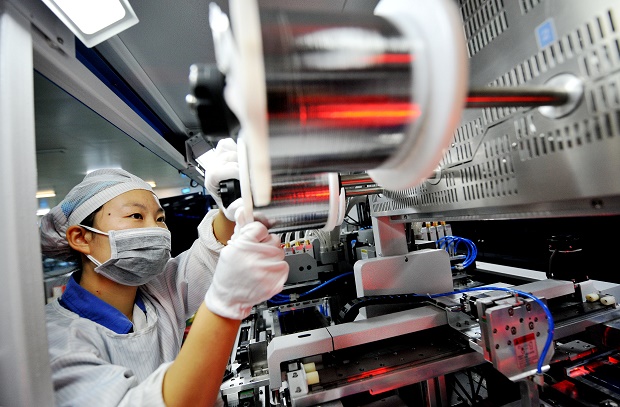
In this Oct. 11, 2015 photo, a woman works with equipment in a factory manufacturing solar power panels in Shangrao in central China’s Jiangxi province. China’s economic growth decelerated in the latest quarter but relatively robust spending by Chinese consumers helped to avert a deeper downturn. The world’s second-largest economy grew by 6.9 percent in the three months ended in September, the slowest since early 2009 in the aftermath of the global crisis, data showed Monday, Oct. 19, 2015. That was down from the previous quarter’s 7 percent. AP
BEIJING, China — Activity in China’s vast manufacturing sector shrank for the third month in a row in October, officials said Sunday, adding to fears that growth in the world’s second largest economy is slowing faster than policy makers admit.
The official Purchasing Managers’ Index (PMI) came in at 49.8 last month, the National Bureau of Statistics said in a statement.
The indicator tracks activity in China’s crucial factory and workshop sector and was unchanged from the previous month. A figure above 50 signals expansion, while anything below indicates shrinkage.
China’s government said its economy grew at 6.9 percent between July and September this year, the slowest pace since the aftermath of the global financial crisis in 2009.
But many analysts believe China’s actual growth is significantly lower, pointing to weakness in trade data and alternative indicators such as the PMI.
Beijing says growth will slow as the economy transitions away from a growth model based on investment and exports towards consumption, but will avoid a “hard landing”.
The government has issued a series of policies aimed at stimulating growth, last week abolishing its official cap on interest rates for savers and announcing further easing in monetary policy.
But government intervention to see off a stock market rout this summer has increased doubts over policy makers’ competence in managing a transition to a more market-based economy.
The latest figure shows ongoing “sluggish” economic activity, Australian bank ANZ said in a statement.
“While the PMI has stabilized, it is too early to confirm a bottoming out,” it said, adding that further monetary easing was likely.